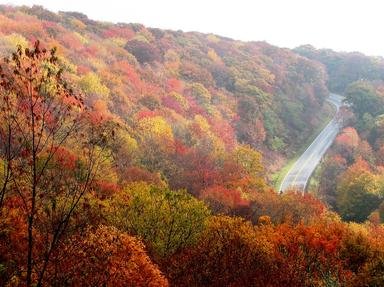Quiz Answer Key and Fun Facts
1. The state of North Carolina is geographically divided into three regions or landforms. Which of the following is NOT one of them?
2. A line of hills running north to south through the middle of North Carolina separates the rocky, rolling hills of the Piedmont plateau from the sandy, gently sloping plain of the eastern part of the state. What is this geographical feature, or escarpment, called?
3. To indicate that something covers the whole of North Carolina from west to east, natives of the state proverbially use what phrase mentioning two cities on opposite ends of U.S. Highway 64, almost 600 miles (970 kilometers) apart?
4. What peak, in the Black Mountain sub-range of the Blue Ridge/Appalachian Mountains, measures in as the highest point in North Carolina at 6,684 feet (approximately 2,037 meters) above sea level and is the highest elevation east of the Mississippi River?
5. The ranges and sub-ranges of the Blue Ridge/Appalachian Mountains comprise some of the oldest mountain chains in North America. What is the oldest, lowest, and easternmost of these ranges, named for a Native American tribe that once made a home there?
6. On the summits of some mountains in the Southern Appalachians - primarily in North Carolina but also in Tennessee, Georgia, and Virginia - areas of grass or heath grow where forests normally would appear in regions with cooler climates. What term is used for these mountaintop meadows that have been called "an ecological enigma" by scientists?
7. The town of Pilot Mountain, North Carolina, on U.S. Highway 52 in the inner Piedmont region, is named for a nearby landform that was designated a U.S National Natural Landmark in 1976. Called in some countries an "inselberg" and colloquially in America a "knob", what type of isolated mountain is made of hard rock (in this case, metamorphic quartzite) from which all the softer rock has worn away?
8. Home of the Venus fly trap, a carnivorous plant native only to the inner coastal plain of southeastern North Carolina, what verdant U.S. National Natural Landmark is found in Brunswick and Columbus counties, about twenty miles from Wilmington?
9. The coastline of North Carolina is characterized by many estuaries, inlets, lagoons, capes, and barrier islands, as well as the two largest landlocked sounds in the United States. What are the names of these two sounds, separated from the Atlantic Ocean by the barrier islands of the Outer Banks?
10. First called "Rio Jordan" by Spanish explorers in 1526, what river's system is the largest in North Carolina, including tributaries that flow through 29 of the state's 100 counties?
Source: Author
nannywoo
This quiz was reviewed by FunTrivia editor
Pagiedamon before going online.
Any errors found in FunTrivia content are routinely corrected through our feedback system.

